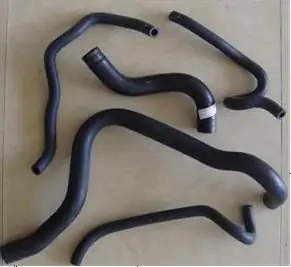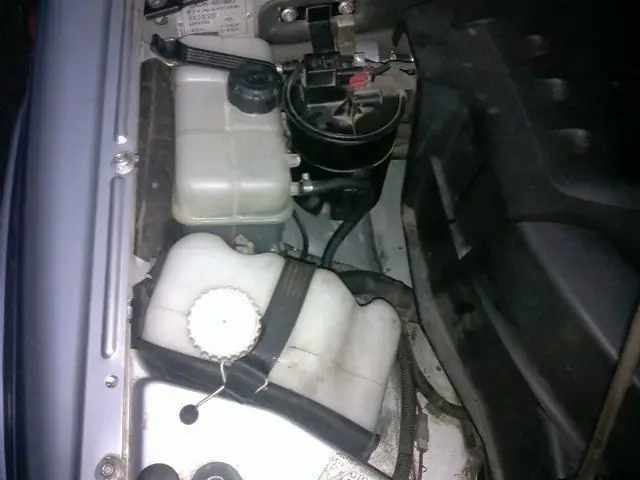2025 Author: Erin Ralphs | [email protected]. Last modified: 2025-01-22 21:14:18
Every car uses an internal combustion engine. Liquid cooling systems are widely used - only on the old "Zaporozhets" and the new "Tata" air blowing is used. It should be noted that the coolant circulation scheme on all machines is almost similar - the same elements are present in the design, they perform identical functions.
Small cooling circle
In the circuit of the internal combustion engine cooling system, there are two circuits - small and large. In some ways, it is similar to human anatomy - the movement of blood in the body. The liquid moves in a small circle when it is necessary to quickly warm up to operating temperature. The problem is that the motor can function normally in a narrow temperature range - about 90 degrees.

You can't raise or lower it, sohow this will lead to violations - the ignition timing will change, the fuel mixture will burn out of time. The interior heater radiator is included in the circuit - after all, it is necessary that the inside of the car be warm as soon as possible. The supply of hot antifreeze is blocked with a tap. The place of its installation depends on the specific car - on the partition between the passenger compartment and the engine compartment, in the glove box area, etc.
Large cooling circuit
The main radiator is also included in the engine cooling system. It is installed in the front of the car and is designed to urgently reduce the temperature of the fluid in the engine. If the car has air conditioning, then its radiator is installed nearby. On Volga and Gazelle cars, an oil cooler is used, which is also placed in front of the car. A fan is usually placed on the radiator, which is driven by an electric motor, a belt or a clutch.
Liquid pump in the system
This device is included in the circulation circuit of the coolant "Gazelle" and any other car. The drive can be carried out as follows:
- From the timing belt.
- From the alternator belt.
- From a separate belt.

The design consists of the following elements:
- Metal or plastic impeller. The efficiency of the pump depends on the number of blades.
- Case - usually made of aluminum and itsalloys. The fact is that this particular metal works well in aggressive conditions, corrosion practically does not affect it.
- Pulley for installing the drive belt - toothed or wedge-shaped.
- Shaft - a steel rotor, at one end of which there is an impeller (inside), and outside a pulley for installing a drive pulley.
- Bronze bushing or bearing - lubrication of these elements is carried out using special additives that are found in antifreeze.
- The oil seal prevents fluid from leaking out of the cooling system.
Thermostat and its features
It is difficult to say which element provides the most efficient circulation of liquid in the cooling system. On the one hand, the pump creates pressure and the antifreeze moves through the nozzles with its help.

But on the other hand, if there were no thermostat, the movement would occur exclusively in a small circle. The design contains the following elements:
- Aluminum body.
- Outlets for connection with nozzles.
- Bimetallic type plate.
- Mechanical spring return valve.
The principle of operation is that at temperatures below 85 degrees, the liquid moves only along a small contour. At the same time, the valve inside the thermostat is in such a position that the antifreeze does not enter the large circuit.
As soon as the temperature reaches 85 degrees, the bimetallic plate will begin to deform. It acts on a mechanical valve andallows antifreeze access to the main radiator. As soon as the temperature drops, the thermostat valve will return to its original position under the action of the return spring.
Expansion tank
There is an expansion tank in the cooling system of the internal combustion engine. The fact is that any liquid, including antifreeze, increases volume when heated. As it cools, the volume decreases. Therefore, some kind of buffer is needed in which a small amount of liquid will be stored so that there is always plenty of it in the system. It is with this task that the expansion tank copes - the excess splashes there during heating.
Expansion tank cap
Another indispensable component of the system is the cork. There are two types of construction - hermetic and non-hermetic. In the event that the latter is used on the car, the plug of the expansion tank has only a drain hole through which the pressure in the system is balanced.

But if a sealed system is used, then there are two valves in the plug - an inlet valve (takes air from the atmosphere inside, operates at a pressure below 0.2 bar) and an exhaust valve (operates at a pressure above 1.2 bar). It expels excess air from the system.
It turns out that the pressure in the system is always greater than in the atmosphere. This allows you to slightly increase the boiling point of antifreeze, which favorably affects the operation of the engine. This is especially good for driving in traffic jams in urban areas. An example of a sealed system -cars VAZ-2108 and similar. Leaky - models of the classic VAZ series.
Radiator and fan
Coolant circulates through the main radiator, which is installed at the front of the vehicle. Such a place was not chosen by chance - when driving at high speed, the radiator cells are blown by an oncoming air flow, which ensures a decrease in engine temperature. A fan is installed on the radiator. Most of these devices are electrically powered. Gazelles, for example, often use clutches similar to those used on air conditioning compressors.

The electric fan is switched on using a sensor installed at the bottom of the radiator. The signal from the temperature sensor, which is located on the thermostat housing or in the engine block, can be used on injection machines. The simplest switching circuit contains only one thermal switch - it has normally open contacts. As soon as the temperature reaches 92 degrees at the bottom of the radiator, the contacts inside the switch will close and the fan motor will be energized.
Interior heater

This is the most important part when viewed from the driver's and passengers' point of view. Comfort when driving in the winter season depends on the efficiency of the stove. The heater is part of the coolant circuit and consists of the following components:
- Electric motor with impeller. It is turned on according to a special circuit in which there is a constant resistor - it allows you to change the speed of the impeller.
- A radiator is an element through which hot antifreeze passes.
- Cock - designed to open and close the supply of antifreeze inside the radiator.
- A duct system allows you to direct hot air in the right direction.
The scheme of circulation of the coolant through the system is such that when only one inlet to the radiator is closed, hot antifreeze will not get into it in any way. There are cars in which there is no stove tap - there is always hot antifreeze inside the radiator. And in the summer, the air ducts simply close and heat is not supplied to the cabin.
Recommended:
Cooling system device. Branch pipes of the cooling system. Replacing the pipes of the cooling system

The internal combustion engine works stably only under a certain thermal regime. Too low a temperature leads to rapid wear, and an excessively high temperature can cause irreversible consequences, up to jamming of the pistons in the cylinders. Excess heat from the power unit is removed by the cooling system, which can be liquid or air
Chevrolet Niva: cooling system. Chevrolet Niva: cooling system device and possible malfunctions

Any car contains several basic systems, without the proper functioning of which all the benefits and pleasure of owning can be nullified. Among them: the engine power system, the exhaust system, the electrical system, and the engine cooling system
Car coolant heater. How to install a coolant heater

Starting an engine "cold" is a serious test for any of its systems. A cold start is equal to several tens of kilometers in difficult conditions. Also, the driver and passengers of the car are not very comfortable. So, for all those who live in the cold regions of our country, they need not a leather interior and various options, but a coolant heater
Maintenance and repair of the engine cooling system. Soldering of cooling radiators

During the operation of the car engine, it heats up to sufficiently high temperatures, the cooling system is designed to avoid overheating. Repair, diagnostics and maintenance of this system are very important, as an overheated internal combustion engine will disable the car
Engine cooling fan. Engine cooling fan repair

When the engine cooling fan fails, it is urgent to change it. That is, remove, disassemble, repair and install back. This article shows you how to do it yourself

